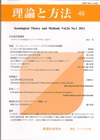Volume 13, Issue 2
Displaying 1-9 of 9 articles from this issue
- |<
- <
- 1
- >
- >|
Special Section
-
1999Volume 13Issue 2 Pages 135-136
Published: January 31, 1999
Released on J-STAGE: September 30, 2016
Download PDF (128K) -
1999Volume 13Issue 2 Pages 137-153
Published: January 31, 1999
Released on J-STAGE: September 30, 2016
Download PDF (997K) -
1999Volume 13Issue 2 Pages 155-168
Published: January 31, 1999
Released on J-STAGE: September 30, 2016
Download PDF (569K) -
1999Volume 13Issue 2 Pages 169-182
Published: January 31, 1999
Released on J-STAGE: September 30, 2016
Download PDF (602K) -
1999Volume 13Issue 2 Pages 183-192
Published: January 31, 1999
Released on J-STAGE: September 30, 2016
Download PDF (585K)
Articles
-
1999Volume 13Issue 2 Pages 193-207
Published: January 31, 1999
Released on J-STAGE: September 30, 2016
Download PDF (738K) -
1998Volume 13Issue 2 Pages 209-224
Published: January 31, 1998
Released on J-STAGE: September 30, 2016
Download PDF (748K) -
1998Volume 13Issue 2 Pages 225-240
Published: January 31, 1999
Released on J-STAGE: September 30, 2016
Download PDF (754K)
Book Reviews
-
1999Volume 13Issue 2 Pages 241-252
Published: January 31, 1999
Released on J-STAGE: September 30, 2016
Download PDF (690K)
- |<
- <
- 1
- >
- >|
